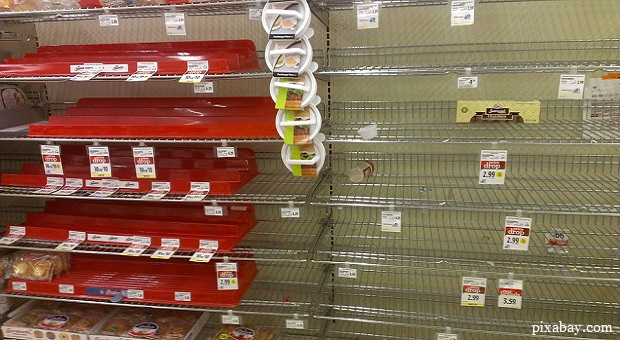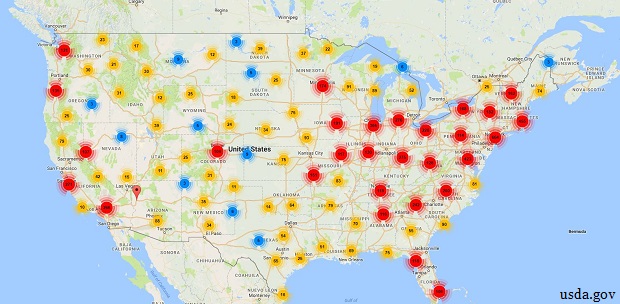The worst has happened.
Just look how hard Texas was hit by Harvey Hurricane.
Disaster has struck and you were caught flat-footed and unprepared. Or maybe you were prepared, but didn’t stockpile enough, or your supply was compromised.
For whatever reason, you go to the grocery store because you’re out of water and food but the shelves are bare. So where do you turn when you need to buy food but the grocery store shelves are empty?
First, if you were caught without any type of prepping, you should have been prepared, and are now learning the hard way why! But, that’s spilt milk, so the only place to look is forward. Fortunately, there are a few tricks.
Nowhere in this list will you find any method that suggests that you steal from your neighbors, loot stores, or ransack empty houses. And if you do, unless we’re in the middle of an apocalypse and those people are dead or gone for good, then shame on you.
And be aware that if you do get caught, it may not be by the police – you may find yourself looking down the wrong end of the owner’s .45.
Video first seen on KENS 5.
Grocery Store Dumpsters
Before you get all high and mighty about this, let me remind you that grocery stores regularly throw out perfectly good food because it’s a couple of days old or, in the case of power outages, have to throw all perishable goods out due to policy. The kicker here is that they’re not even allowed to give it away for free.
If the power goes out for more than just a half-day or day, or whatever, they generally have a CYA policy that, even though the food is still semi-frozen and people are standing at their doors going hungry, they have to pitch it.
So, dumpsters behind grocery stores are a great place to store perfectly good food. A word of warning here, though: If you’re digging through meat, don’t take any that isn’t still at least cold, especially fowl. Salmonella is not your friend.
This a good place to score produce, milk, bread, frozen foods, baked goods, or deli items for free. But keep an eye out and be there as soon as employees can make it back to the store, because they’ll be throwing everything out immediately.
Food Pantries
Food pantries typically try to stock up before a storm because they know that people are going to need help. Unlike the commoner, they have a relationship with local grocery stores and can get meat, produce, and bakery items that are a day or two old or are otherwise not ideal to sell at the store, but are still perfectly edible.
These Are The Ingenious Recipes That Helped Our Ancestors Stay Alive!
Just as with grocery stores, be there as soon as you can get there, because they’ll run out fast.
Emergency and Homeless Shelters
These two places are typically targeted as drop-spots for food and water because it’s a given that everybody there has nothing and the entire goal of a shelter is to provide a safe haven for people in need.
Soup kitchens are the same, though they will often run out quickly either because the food was compromised or because so many people show up with empty bellies after a disaster.
Farmers Markets
Local farmers tend to be a generous lot, and also often have generators to keep them from losing all of their produce, which are their livelihood as well as their own food source.
You’ll often find these set up along the road offering produce and home-canned goods, and maybe even eggs and bread, or search for one on USDA website. Sometimes they’ll be giving food away, but usually you’ll pay for it. If it’s a little extra, that’s sort of what you get for not being prepared.
Designated Assistance Locations
The county, state, and federal government emergency response teams will designate specific locations where they will portion out food, water, ice, and often paper goods, hygiene items, and clothes.
These spots may even be equipped with phones so that you can contact loved ones, a food or barbecue area, and air-conditioned or heated areas where you can get out of the weather for a few minutes. Their resources are considerably vaster, but they’re not unlimited, especially in the first few days post-disaster.
Restaurants
There’s always going to be a few restaurants that have backup generators and/or use gas stoves so that they can operate even without electricity.
When Hurricanes Charley and Ivan went through, I was living in Southwest Florida and working as a waitress. We were one of only a handful of restaurant in ten miles that was open because we had a generator and gas stoves.
The owner, a brilliant man, saw the opportunity coming and stocked up on food right before the storms, opened as soon as the roads opened, and made an absolute killing even though he sold most everything at a discount.
I lived close and was able to make it to work. Let me tell you, those few days when there was no power were some of my most profitable of my entire stint there.
So, if you have money, some local restaurants will likely be open if it’s a disaster like this. Also, even if they can’t open, they’ll likely go in to clean out the freezers, so their dumpsters will be full, too.
You can also possibly get lucky enough that they’ll give it to you instead of wasting it or sell it to you.
Bartering
Do you have a friend who had the foresight to stockpile but had damage to his home? Consider trading your spare bedroom or couch for some of his food.
You may also be able to barter with neighbors who need help clearing trees or stabilizing porches or roofs – your work in exchange for food.
The Land
This isn’t an option that is available to or feasible for everyone, but if you happen to live in an area that is abundant with berries, nuts, and wildlife, and you’re equipped and knowledgeable enough to hunt or gather, then this may be an option for you.
If you don’t know what you’re doing, you’re better off skipping this step because one berry will feed you, but another may kill you.
These are about the extent of places that you’ll be able to find food after a SHTF situation, so you better be ready to beat other people in your shoes to the punch by being out and on patrol early. The takeaway here is that you’re going to be stuck either going through dumpsters or paying – often through the nose – for food at restaurants or from roadside stands.
If you can’t make it on your own, know where your local shelters are and keep an ear out for designated food and water allocation stations.
If you’re without food because you were unprepared or underprepared, don’t make the same mistake twice. There’s really no place that isn’t susceptible to some sort of disaster – hurricanes, blizzards, tornadoes, floods – so don’t be caught unaware.
If you’re unfortunate enough to find yourself in need of food after a disaster, at least learn your lesson: know what to do and where to find food by researching food sources in advance!
If you can think of any resources that I missed, please share them with us in the comments section below.
This article has been written by Theresa Crouse for Survivopedia.










pelagiaeast | August 31, 2017
|
The map is interesting, but no key. What are the yellow, red and blue bursts supposed to mean? Can you redo it so it is large enough to read, and has the key? I am in KS, but it appears that nothing is listed for the Wichita area, which happens to be the most heavily populated part of ks.
Thanks for a good article, but please help with this important part.
zerogee4me | September 1, 2017
|
Here is the link from higher up in the article: https://search.ams.usda.gov/farmersmarkets/googleMapFull.aspx
The spots on the map in the article are basically showing areas with many, some, and few farmers markets nearby, with red being the most.
Hope that helps.
David Camery | August 31, 2017
|
These are very good points that could very well keep you and your group for a period. But as we all know, when the SHTF, it all planned ways go out the window, so we must strive to remain alive thru any means possible. I will survive until God calls.
Jerry Strange | August 31, 2017
|
Thank you, Theresa. Very good information to have.
henry | August 31, 2017
|
Hello Theresa, very good article, we all wish more folks would take heed. Its not a matter of “if” a major disaster strikes, its “when” it will happen. I have talked with many acquaintances over the years, and far too many say that if the shtf, they want to be at ground zero. That’s why I have turned cold toward these lazy types , like why would I share my provisions with them and then have my stockpile deplentished? even in the biblical days the people stored up grains to maintain the food source in case of a drought or famine. my instincts and insights tell me that before this year ends something bad is going down, like WW3; an emp attack; 10.0 earthquake; power grid permanent shut down; economic collapse; civil war; and on and on.
Lone survivor | August 31, 2017
|
Great article. You foRgot one location: a pet store. Its not my first choice, but its Food.
WS Woods | August 31, 2017
|
Don’t forget fishing, hunting and trapping, too. These age old country skills kept the Lewis and clark expedition alive for three years in the wilderness. If you have kids, teach them how to fish, hunt and trap, then take them out in the woods and help them get experience. Boy Scouting, 4H, NRA training, local shooting clubs, state hunter safety courses, summer camps are all good sources for this type of training for both kids and adults. Hank williams jr said it well in his song; “a country boy can survive”. (NRA life member & instructor, 55 years in Scouting and 4h)
randy Dutton | September 1, 2017
|
Hunting and fishing for survival is the strategy for many in our area of the Pacific Northwest following a disaster. Problem is that our coastal waters, will be heavily contaminated; Fuel for boats to go far offshore will be hard to find (if the boats survive a tsunami); and once hunters start shooting, the game will flee far away into the mountains. Then after a couple days of failed searching, some hunters will train their sights on local livestock. and when poachers kill livestock they’ll waste much of the carcass because they can only carry so much.
Randy DuttON | August 31, 2017
|
You left out a valuable food source. Many local ranchers would gladly sell a steer at a reasonable price. During a disaster ranchers may need to reduce their herd because of a loss of feed, hay, fuel, or even reduced security needed to protect it from rustlers. Buy a steer and butcher it. If you have a deep freezer and generator, you’re set. Otherwise, barter or donate some, or jerk, can, smoke, or freeze dry some. Located in the Pacific Northwest with a megaquake and tsunami threat, I’ve got a small upland herd just for that reason. Oddly, our emergency managers completely ignore the availability of local cattle as a food source despite calculations that show our 6,000+ cattle could provide up to 120 meals per person in the county. Despite FEMA telling our county that we are on our own for the first 14 days after a tsunami, our Emergency Managers would rather rely upon government to airdrop food into our county than set up a contingency contracting operation to buy local livestock and use it to feed the refugees.
Sherril Woods | August 31, 2017
|
I’m almost out of food , BUT not because I have not been prepared! I have several diseases that don’t let me eat like normal people! I can’t have any meat, nothing green, nothing with nitrites or nitrates. I am allergic to eggs, no wheat, barely, rye,malt, no Gluten only special butter and milk. Nothing from a can, nothing prefrozen! No yogurt, I have to go to specialty stores. Which I have been doing, but I can’t afford the products I need. My special bread is 6+dollars a loaf, and there are only 12 slices in a loaf! I also can’t have peanut butter or any oil except extra virgin olive oil. Can’t have anything fizzy. Sage and ginger stop my kidneys from working. So that’s my scenario!
Susan | September 1, 2017
|
Real sorry to hear that. Have faith and hope in God, and think positive.
Linda Dee | September 13, 2017
|
Check out Dr. AXE on the internet. He said most problems begin in the gut. my husband has a rare type of dementia and is improving tremendously. i have high blood pressure, food allergies, and diabetes. All of my problems are also improving. We are both following his program.
Grammyprepper | August 31, 2017
|
I work at a grocery store and it is shameful the amount of food that gets thrown out. And that is on top of all the donations that are made. Couple of words to the wise tho…our store uses a very large closed container type dumpster system. It is not easily accessed from the outside. In addition, it is not emptied every or even every other day. So IF you can get there at the point in time when things are being pitched, AND you find an access point, you may very well have to wade or dig through some pretty nasty stuff to get to the somewhat decent stuff.
Now mind you, this is a larger chain store. Smaller stores, and mom and pop stores might be a different story. Diving might be easier there.
And in an emergent situation, stores ‘may’ be more likely to still sell and/or give away even ‘borderline’ items.
Just my two cents. Better to be as prepared as you can beforehand. While nowhere as prepared as I would like to be, I know I am better off than the masses.
JC | September 1, 2017
|
Schools have kitchens and need to throw away food if the power goes out. They may do it later when the school reopens, so either it will be spoiled or you will be able to stretch your supply by a few more days. Don’t forget feed stores for grains, hardware stores for snacks. Arenas and ball fields have snack bars.
Norm | September 3, 2017
|
To J C, my school where i spent tens years has “no” kitchen that really cooks foods. All our food is just heated in large microWaves. I can remember a morning the pta was doing omelettes and we needed another fry pan, i,had to run home, grabed mine and rushed back.. not like the good old days when i was in school. Of course, tpday’s food doen’t compare neither.